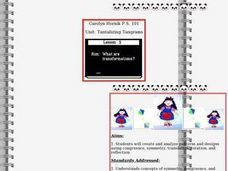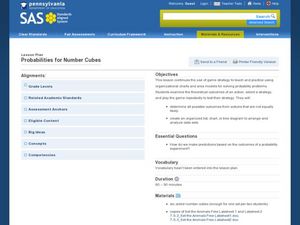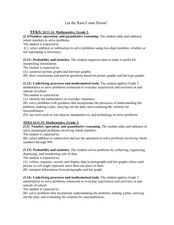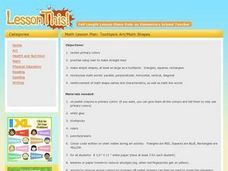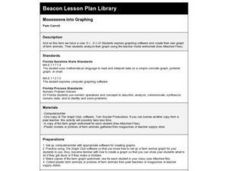Curated OER
Tantalizing Tangrams: What Are Transformations?
Students use the Internet to learn about transformations and tessellations. In this geometry lesson, students use the Internet to define the meaning of reflections, translations, rotations, glide reflection and symmetry. ...
Curated OER
How many seeds?
Students investigate seeds and find the difference between seeds and nuts. In this seeds and nuts lesson, students predict, then count the number of seeds in an apple. Students record and share their results. Students compare...
Curated OER
Arthur Young and the President
Students work with NASS data by converting it into prose. In this historical agriculture information lesson, students read about how George Washington communicated information about crop yields, livestock, and land values. They apply the...
Curated OER
Carrying Capacity of Ecosystems
Students define population and carrying. In this algebra lesson, students explore exponential growth and decay based on animals and things that grow or decrease exponentially. They graph their findings and discuss their results as they...
Curated OER
Six of One, Half Dozen of the Other
Students explore the garden with all five senses. In this Science lesson plan, students collect specimens from the garden to classify. Students use adjectives to describe the objects collected.
Curated OER
Bug Sweep
Students observe and categorize insects. In this insects science lesson, students create a bug catcher out of a coat hanger and plastic bag, then collect bugs from the schoolyard. Students count and categorize the insects according to...
Curated OER
Probabilities for Number Cubes
Learners explore the concept of probability. In this probability lesson, students roll a six-sided number cube and record the frequency of each outcome. Learners graph their data using a frequency chart and keep tally marks...
Curated OER
The Real Number System
Learners analyze the real number system. They discuss real numbers, rational and irrational numbers, integers, whole numbers, natural numbers and more of the real number in the system. They differentiate between all these numbers.
Curated OER
Volume of Spheres
Students find the volume of spheres. In this geometry lesson, students measure and derive the formula for each shape and solid. They use the correct terminology and units when solving these problems.
Curated OER
Multiplying Polynomials
Students explore the concept of multiplying polynomials. In this multiplying polynomials lesson, students watch a video clip about basic math skills. Students work in groups on an exploration about why a binomial squared equals a perfect...
Curated OER
Simplify Expression Using the Order of Operations
Allow learners to explore both the right and wrong way of completing equations with the order of operations. They discuss how the order in which operations are performed affects the outcome of a problem. A fun "trick" using order of...
Curated OER
Money Management Part I: Money and You: An Introduction to Money Management and Budgeting
Learners discuss personal finance and create personal budgets. They discuss the importance of managing their money and how money management skills impact their future. Note: This lesson is intended for use with a SMART Board and...
Curated OER
Does the Area of the Quadrilateral Change?
Students study area and quadrilaterals. In this multiplication and area lesson, students use Polystrip models to change rectangles to form different parallelograms. Students find the area of the models use a Geometer Sketchpad to find...
Curated OER
Let the Rain Come Down!
Second graders construct a bar graph comparing local precipitation to that of the Yucatan. In this graphing lesson, 2nd graders will use conversions and problem solving strategies.
Curated OER
Squares, Square Roots, and Exponential Expressions
Students explore the concepts of square roots and exponential expressions. In this square root and exponential expression instructional activity, students complete an investigation called Building A Square Patio. Students use color tiles...
Curated OER
Telling Time: Two Ways to Read the Time
Second graders discuss the two different ways of reading time. They study the vocabulary "minutes to" and tell time in five minute intervals. They discuss why it is important to have schedules and students list some schedules that they...
Curated OER
Morphemic Analysis
Young scholars analyze content area vocabulary. In this content area literacy lesson, students list math words they are unfamiliar with and identify morphemes found in those words that are found in other words. Once they have a list of...
Curated OER
Odd and Even Numbers
First graders practice number identification by reading a story in class. In this number sense lesson, 1st graders read the story A Wish for Wings that Work and identify objects within the book's photographs. Students count the number of...
Curated OER
Give It a Whirl
Students examine and identify polyhedron shapes on a math website. They write journal reflections about two- and three-dimensional shapes, and transform a square into a pinwheel.
Curated OER
Let's Explore Patterns
Second graders define the word pattern and other related vocabulary. They create a pattern independently. Students recognize and extend patterns. They explain how repeated patterns are made. Students explore several patterns on a...
Curated OER
Toothpick Art
Learners review primary colors and practice making straight lines. In this visual arts instructional activity, students paint simple shapes as large as a toothpick, using specific primary colors. During the construction of the shapes...
Curated OER
Symmetry in Kaleidoscope Designs
Students define reflection, rotation and symmetry. In this symmetry lesson, students move the graph around the coordinate plane and identify the line of symmetry. They identify the different designs of a kaleidoscope.
Curated OER
Moooooove into Graphing
First graders explore graphing software and create their own graph of farm animals. Then students analyze their graph using the teacher made worksheet which is imbedded in this lesson plan. Great lesson!
University of New Mexico
Lesson Plans and WebQuests
Students review an overview of mediation techniques and listening skills. They practice good listening skills which are needed for the mediation process and discuss icebreakers in pairs to better utilize good listening skills.
